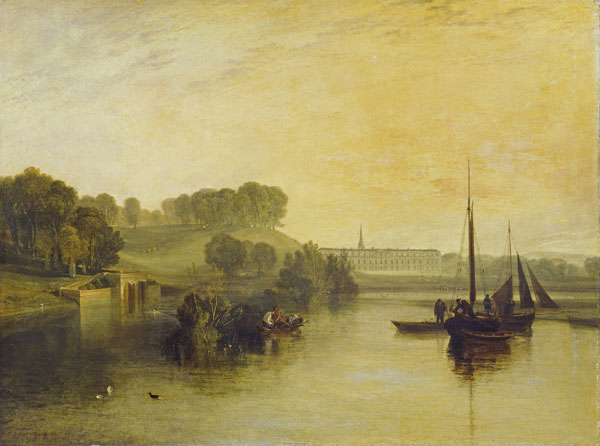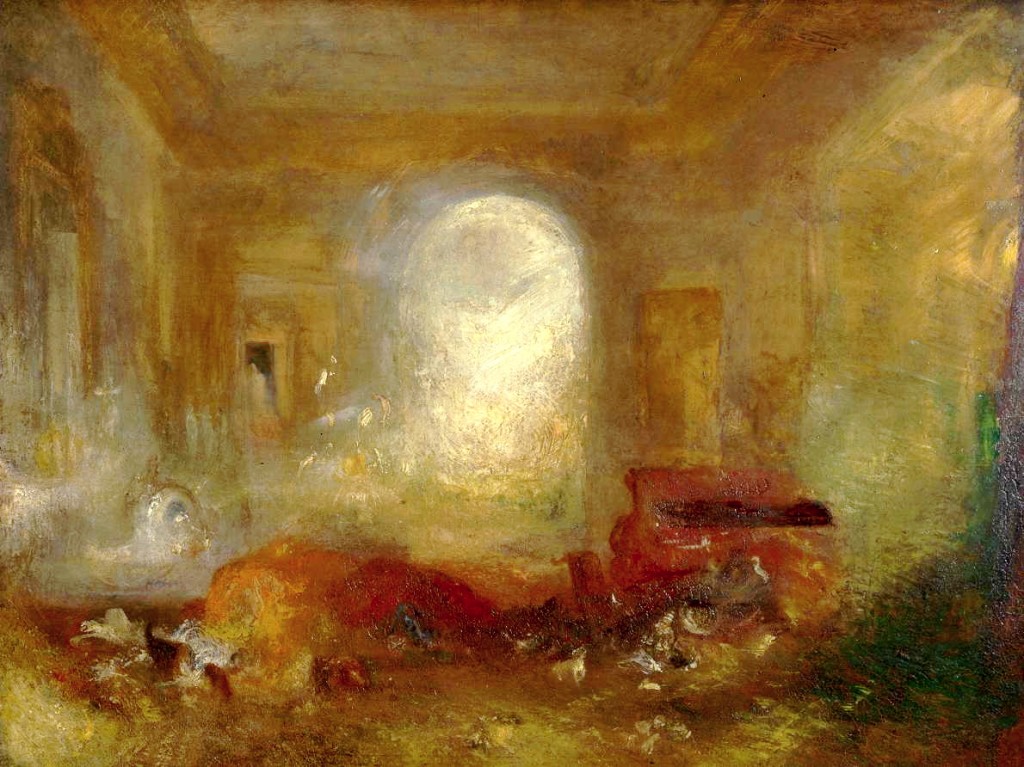Lord Egremont’s whims included art and artists, and Turner painted luminous works at Petworth for him….
One autumn morning in 1826 an uncommonly gifted writer, who, with far less justification, imagined that he was a great artist, awoke to congratulate himself on his good fortune. Benjamin Robert Haydon, author of the famous Autobiography and a painter of enormous disjointed historical scenes with such titles as Alexander Taming Bucephalus, or Wellington Musing at Waterloo, had recently been the inhabitant of a debtor’s prison, ” the companion of gamblers and scoundrels-sleeping in wretchedness and dirt, on a flock bed low and filthy.” He now opened his eyes beneath the canopy of a velvet-curtained four poster and saw an array of splendid ancestral portraits glimmering through the shadows of the room. He was at Petworth, he remembered , the guest of a millionaire patron of contemporary art: “God in heaven,” he exclaimed, “grant my future may now be steady. At any rate a nobleman has taken me by the hand, whose friendship generally increases in proportion to the necessity of its continuance. Such is Lord Egremont.”

---The two great English landscape painters, JMW Turner (1775-1851) and John Constable (1776-1837) both painted the Downs landscape. For artists working then, private patronage was one of the few ways of making a living. The 3rd Earl of Egremont had a large country estate in Petworth, West Sussex. He was an important patron because he encouraged artists to paint subjects that interested them. He invited Constable to Petworth but it is his relationship with Turner that produced the most influential body of work.---Read More:http://www.southdowns.gov.uk/learning/themes-to-study/cultural-heritage/art/private-patronage
Around the house stretched the immense, magnificently landscaped park and the long artificial lake that had already provided Turner with some of his most enchanting subjects. For Lord Egremont had many other proteges, whom he encouraged to treat his house as an artistic caravansary, and whose pictures he was fond of purchasing to set off his collection of old masters. He was naturally generous; and he could afford to be generous , having succeeding to an earldom when he was twelve years old, and with it he inherited an income of more than 200,000 pounds sterling per annum. He could afford to be eccentric and made full use of his opportunities.

---Turner apparently burst into tears when he first saw Claude's 1648 Seaport with the Embarkation of the Queen of Sheba. As well as being moved, he probably realised how far he would have to go to beat Claude as a painter. There is nothing new in this observation; nor does this exhibition have anything new to say about the relationship between the two artists. By the end of the 18th century, when Turner was in his 20s, Claude's work was held in high esteem in Britain: at least 30 of his paintings were held in collections, and his work was also a major influence on private parks and gardens. If we can't get enough Turner now, they couldn't get enough Claude then.---Read More:http://www.guardian.co.uk/artanddesign/2012/mar/12/turner-claude-national-gallery-review
Born in 1751, the friend and schoolfellow of Charles James Fox, he had entered the London world under the aegis of the dissolute Prince of Wales, and for some years had divided his time between politics, fashion, racing, and the improvement of his vast estates. And Egremont did not choose to settle down in marriage with some suitably rich and wellborn girl. He suffered, his critics alleged, from “indiscretion and irresolution.” What was more, he had fallen under the spell of a fashionable London beauty-Lady Melbourne, later Byron’s confidante, whose second son, William Lamb, afterwards Queen Victoria’s first Prime Minister, was widely believed to be Lord Egremont’s illicit offspring. Her portrait, painted by Joshua Reynolds- a shrewd, sensuous, seductive face, now hangs in the room at Petworth that was once his bedchamber.
As the century approached its close, Egremont’s interests veered toward art; but whereas his father, the second Earl, had begun to enlarge the family collection when traveling on the Grand Tour and had brought home some fine Italian paintings, he himself was chiefly attracted by the productions of the modern English school. Then, early in the new century, he became Turner’s patron and personal friend; and their friendship, despite every kind of superficial difference, lasted until his death.
Egremont was a hereditary grandee with, what Joseph Farington once complained, “had a great deal of the Peer about him,” while Turner, the son of a miserly London barber, had inherited his parent’s mierliness, “Dad” he recorded, “never praised me except for saving a shilling,” and made no attempt to cut a gentlemanly figure. We hear of him at Petworth in 1809, when he resembled a prosperous “master carpenter, with lobster-red face,twinkling, staring gray eyes, white tie, blue coat with brass buttons…turned up boots, large fluffy hat and enormous umbrella.”
And in the following year he is described as a “little Jewish-nosed in an ill-cut brown coat, striped waistcoat, and…frilled shirt, sketching on a small piece of paper, held almost level with his waist.” His private life was sordid and complex, occupied with a strange succession of clandestine love affairs. Now he would vanish among the brothels and taverns of London’s dockside East End; now, as “Admiral Puggy Both,” he would be discovered living incognito in a secluded hose with one of his various middle-aged favorites.









 COMMENTS
COMMENTS



